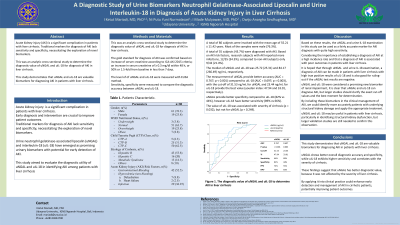Monday Poster Session
Category: Liver
P2874 - A Diagnostic Study of Urine Biomarkers Neutrophil Gelatinase-Associated Lipocalin (uNGAL) and Urine Interleukin-18 (uIL-18) in Diagnosis of Acute Kidney Injury in Liver Cirrhosis
Monday, October 28, 2024
10:30 AM - 4:00 PM ET
Location: Exhibit Hall E

Has Audio

I Ketut Mariadi, MD
Udayana University
Denpasar, Bali, Indonesia
Presenting Author(s)
I Ketut Mariadi, MD1, Ni Putu Yuni Nurmalasari, 1, I Made Mulyawan, MD2, Dwijo Anargha Sindhughosa, MD1
1Udayana University, Denpasar, Bali, Indonesia; 2Udayana University / Prof. Dr. I.G.N.G. Ngoerah Hospital, Denpasar, Bali, Indonesia
Introduction: Acute kidney injury (AKI) is a significant complication in patients with liver cirrhosis. Early diagnosis and intervention are crucial to improve patient outcomes. Traditional markers for diagnosis of AKI lack sensitivity and specificity, necessitating the exploration of novel biomarkers. Urine neutrophil gelatinase-associated lipocalin (uNGAL) and interleukin-18 (uIL-18) have emerged as promising urinary biomarkers with potential for early detection of AKI. This study aimed to evaluate the diagnostic utility of uNGAL and uIL-18 in identifying AKI among patients with liver cirrhosis
Methods: This was an analytic cross-sectional study to determine the diagnostic value of uNGAL and uIL-18 for diagnosis of AKI in liver cirrhosis. The gold standard for diagnosis of AKI was confirmed based on increase of serum creatinine according to ICA-AKI 2015 criteria; an increase in serum creatinine of ≥ 0.3 mg/dl within 48 h, or 50% or 1.5-fold from baseline in less than 7 days. The level of of uNGAL and uIL-18 were measured with ELISA method. Sensitivity, specificity were measured to compare the diagnostic accuracy between uNGAL and uIL-18.
Results: A total of 80 subjects were involved with the mean age of 55.21 ± 11.42 years. Most of the samples were male (76.3%). A total of 35 subjects (43.7%) were diagnosed with AKI. The median of uNGAL and uIL-18 was 25.72 (25.31) and 84.17 (266.49) ng/mL, respectively. The measurement of uNGAL provide better accuracy (AUC = 0.767; p < 0.001) compared to uIL-18 (AUC = 0.697; p = 0.003), with the cut-off of 31.53 ng/mL for uNGAL and 23.44 ng/mL for uIL-18 provide the best value (youden index: 47.94 and 33.01, respectively). uNGAL provide better specificity compared to uIL-18 (82% vs 44%), however uIL-18 have better sensitivity (89% vs 66%). The value of uIL-18 was associated with severity of cirrhosis (p = 0.032), but not for uNGAL (p = 0.249).
Discussion: This study demonstrates that uNGAL and uIL-18 are valuable biomarkers for diagnosing AKI in patients with liver cirrhosis. uNGAL shows better overall diagnostic accuracy and specificity, while uIL-18 exhibits higher sensitivity and correlates with the severity of cirrhosis. These findings suggest that uNGAL has better diagnostic value, because it was not affected by the severity of liver cirrhosis. By applying it into clinical practice could enhance early detection and management of AKI in cirrhotic patients, potentially improving patient outcomes.
Disclosures:
I Ketut Mariadi, MD1, Ni Putu Yuni Nurmalasari, 1, I Made Mulyawan, MD2, Dwijo Anargha Sindhughosa, MD1. P2874 - A Diagnostic Study of Urine Biomarkers Neutrophil Gelatinase-Associated Lipocalin (uNGAL) and Urine Interleukin-18 (uIL-18) in Diagnosis of Acute Kidney Injury in Liver Cirrhosis, ACG 2024 Annual Scientific Meeting Abstracts. Philadelphia, PA: American College of Gastroenterology.
1Udayana University, Denpasar, Bali, Indonesia; 2Udayana University / Prof. Dr. I.G.N.G. Ngoerah Hospital, Denpasar, Bali, Indonesia
Introduction: Acute kidney injury (AKI) is a significant complication in patients with liver cirrhosis. Early diagnosis and intervention are crucial to improve patient outcomes. Traditional markers for diagnosis of AKI lack sensitivity and specificity, necessitating the exploration of novel biomarkers. Urine neutrophil gelatinase-associated lipocalin (uNGAL) and interleukin-18 (uIL-18) have emerged as promising urinary biomarkers with potential for early detection of AKI. This study aimed to evaluate the diagnostic utility of uNGAL and uIL-18 in identifying AKI among patients with liver cirrhosis
Methods: This was an analytic cross-sectional study to determine the diagnostic value of uNGAL and uIL-18 for diagnosis of AKI in liver cirrhosis. The gold standard for diagnosis of AKI was confirmed based on increase of serum creatinine according to ICA-AKI 2015 criteria; an increase in serum creatinine of ≥ 0.3 mg/dl within 48 h, or 50% or 1.5-fold from baseline in less than 7 days. The level of of uNGAL and uIL-18 were measured with ELISA method. Sensitivity, specificity were measured to compare the diagnostic accuracy between uNGAL and uIL-18.
Results: A total of 80 subjects were involved with the mean age of 55.21 ± 11.42 years. Most of the samples were male (76.3%). A total of 35 subjects (43.7%) were diagnosed with AKI. The median of uNGAL and uIL-18 was 25.72 (25.31) and 84.17 (266.49) ng/mL, respectively. The measurement of uNGAL provide better accuracy (AUC = 0.767; p < 0.001) compared to uIL-18 (AUC = 0.697; p = 0.003), with the cut-off of 31.53 ng/mL for uNGAL and 23.44 ng/mL for uIL-18 provide the best value (youden index: 47.94 and 33.01, respectively). uNGAL provide better specificity compared to uIL-18 (82% vs 44%), however uIL-18 have better sensitivity (89% vs 66%). The value of uIL-18 was associated with severity of cirrhosis (p = 0.032), but not for uNGAL (p = 0.249).
Discussion: This study demonstrates that uNGAL and uIL-18 are valuable biomarkers for diagnosing AKI in patients with liver cirrhosis. uNGAL shows better overall diagnostic accuracy and specificity, while uIL-18 exhibits higher sensitivity and correlates with the severity of cirrhosis. These findings suggest that uNGAL has better diagnostic value, because it was not affected by the severity of liver cirrhosis. By applying it into clinical practice could enhance early detection and management of AKI in cirrhotic patients, potentially improving patient outcomes.
Disclosures:
I Ketut Mariadi indicated no relevant financial relationships.
Ni Putu Yuni Nurmalasari indicated no relevant financial relationships.
I Made Mulyawan indicated no relevant financial relationships.
Dwijo Anargha Sindhughosa indicated no relevant financial relationships.
I Ketut Mariadi, MD1, Ni Putu Yuni Nurmalasari, 1, I Made Mulyawan, MD2, Dwijo Anargha Sindhughosa, MD1. P2874 - A Diagnostic Study of Urine Biomarkers Neutrophil Gelatinase-Associated Lipocalin (uNGAL) and Urine Interleukin-18 (uIL-18) in Diagnosis of Acute Kidney Injury in Liver Cirrhosis, ACG 2024 Annual Scientific Meeting Abstracts. Philadelphia, PA: American College of Gastroenterology.
